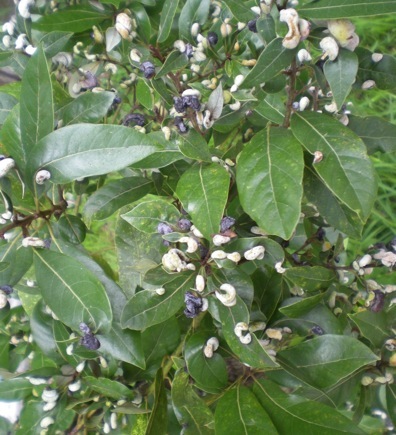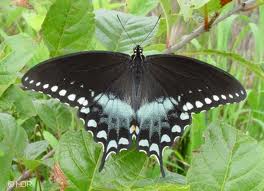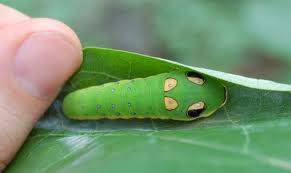
Galls and non-edible fruit on the Persea palustris
Persea borbonia, palustris, humilis, and americana, too
Having a famous relative can make one grow in the shadows, as three Perseas know too well.
There are four Perseas growing in Florida, three of them native, one an import. The import is the most famous, Persea americana (PER-see-uh uh-mair-ah-KAY-nuh.) You know it as the avocado. The other three don’t produce an edible fruit so their drupes are left on the tree. But there is more to the native Perseas than meets the eye.
The unsung natives have leaves that can be used for seasoning, just like a bay leaf, and their leaves can be used to make a tea. Better, no matter what your environment you’re in, one of those Three Leafleteers is near you.
P. humilis (HEW-mil-liss) likes it very dry and is found in scrubby areas. P. palustris (pah-LUS-tris) likes it feet very wet so it is a denizen of swamps. P. borbonia ( bor-BOE-nee-uh) likes it between. Fresh or dried leaves from all three can be used for tea and seasoning. But what of the avocado?
Leaves of the Persea Americana var. drymifolia (PER-see-ua ah-mer-ree-KAY-nuh drim-if-OH-lee-ah) have been used in the distant past for a tea and seasoning. Most of our present-day avocado leaves, Persia americana, are stronger because of breeding and are not usable. One way to tell if you have an ancient avocado tree (the Persea Americana var. drymifolia) is to crush the leaf and smell it. The crushed leaf of the older species should smell like anise or liquorish. The Aztex wrapped food in that leaf for flavoring and called that style of cooking tamale. Cooking with modern-day avocado leaves can make you ill… and don’t eat the avocado pit. It can make you sick or worse. Also keep avocados away from your pets. There is good evidence that cats, dogs, cows, goats, rabbits, rats, birds, fish, and horses can be killed when they consume avocado leaves, bark, skin, or pit.
P. Borbonia is the best known native and is called the Red Bay. Why Red Bay? Bay is the English version of the Latin word Baca, which was the name of similar old world trees in the same family. The “red” comes from the wood of the Borbonia, which has a reddish luster and is prized in woodworking such as for interior finishing and boat interiors. The natives made spoons from it. Oddly, one of the identifying characters of the Perseas are leaf galls, see picture above. Also, Persea borbonia on the east coast of Florida are dying out becaues of a disease.
Borbonia is a mixture of Greek and Latin, Bor — food — and Bon — good, food good, referring to the use of the leaves. Palustris means “of the swamp” and Persea palustris is called the swamp bay. Humilis means low growing. The P. humilis is also known as the “silk bay.” Americana is from the Americas. Drymifolia, from the Greek, is a bit of a mystery. It can mean forest leaf or sharp/stinging/biting leaf.
The Perseas are favored by the Spicebush Swallowtail butterfly. Apparently its concoction of chemicals doesn’t bother it. Oh, and one last thing: It appears that Persea tea provides some protection against giardia.
Lastly the Persea borbonia and the Persea palustris can be difficult to tell apart though they like slightly different environments, the former neither very wet or very dry, the latter can tolerate very wet. But another key is to look at a leaf petiole, main stem on the underside and the underside of the leaf. According to botanist R. P. Wunderling With the P. borbonia little hairs on the petiol lay down, on the P. palustris they stand up. What I have found locally is that P. borbonia has very little hair at all, and what few it has is generally flat. P. palustris is hairy, not only the petiole and the back leaf spine but the back of the leaf as well. To see the hair, or absence of hair, one needs about a 30x magnification.
Green Deane’s “Itemized” Plant Profile
IDENTIFICATION: P. Borbonia, the most common, has lance shaped 4-inch long leaves that are shiny bright green on top and light green on bottom. P. Palustris has leaves that are pale gray on the bottom with hairy red fringes, twigs are hairy. Crushing a leaf produces a very distinct bay leaf odor, the Palustis is not as strong as the Borbonia in aroma. Borbonia can reach 70 feet high and three feet through. Palustris 30 to 40 feet. Fruit of both is a small bright blue to shiny black drupe — NOT EDIBLE. Twigs are slender and the bark reddish-brown and scaly. P. Humilis reaches 10 feet tall. Its leaves are bronze on the underside. The leaves of all the Perseas are often covered with galls. That said it seems to me the P. borbornia seems the most affected by galls.
TIME OF YEAR: Fresh or dried leaves year round
ENVIRONMENT: P. Borbonia, like P. Palustris is found from Virginia south to Florida and west to Texas. P. Humilis is fond only in Central Floirda. Plustris is found in wet areas, Borbonia in neither wet or dry places. Humilis is found in sandy, dry scrub areas.
METHOD OF PREPARATION: Fresh or dried leaves used as a bay leaf or as tea. The fruits of the palustris, borbonia and humilis are NOT edible. Avocado leaves (variation drymifolia) can be used to wrap food if it smells like anise.
HERB BLURB
The leaves have been used as an abortifacient, analgesic, emetic and febrifuge. They have been used to treat fevers, headaches, diarrhea, thirst, constipation, appetite loss and blocked urination. An external decoction wash has been used for rheumatic joints and painful limbs.




I’ve actually used the leaves of (Persea borbonia) as seasoning for some Italian foods. If I make homemade spaghetti and meatballs I usually throw 2-3 fresh green leaves or 3-5 dries leaves to my base red sauce while it’s reducing to add a nice bay flavor.
I’m in Shreveport, Louisiana and this evergreen does well here although I think the tree was planted. It’s growing tall (50 feet or so) and no presence of galls. It’s located near a drainage basin, so imagine it’s feet stay moist most of the time; especially wet season (beginning in late October).
Keep up the good work Green Deane!
– Andrew
Thanks for this info. Just back from MX, I brought home some dried avo leaves from a tree in the yard of the house we rented. And I had no idea that our local native Red Bay is so related to avo’s. I have a Red Bay right by my house, and yes, it has galls. It is about 50 ft from the brackish lagoon in well drained sandy loam. Thanks for sharing all of this good information.
When used as a spice or tea, would you advise against grinding the leaves? Should they be left intact as one would with a bay leaf?
They are usually used intact.
We have a Persea borbonia on our ~1/2 Acre lot here in SE Florida zone 9B. It is ~ 25 feet tall and has sprouted many smaller trees from the surface roots. Tree is loaded with Galls, but seems to be healthy otherwise, producing lots of small Black Drupes each year.
How do you tell the difference between the invasive Camphor tree and the native Red Bay tree here in North Florida? The leaves both look very similar and I think leaves from both have similar flavor. Thank you.
There is a plenty of Red Bay trees in the forest next to my back door. My wife always uses the leaves for cooking. South Carolina.